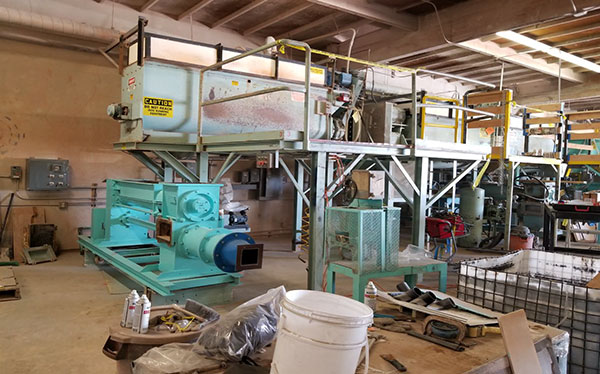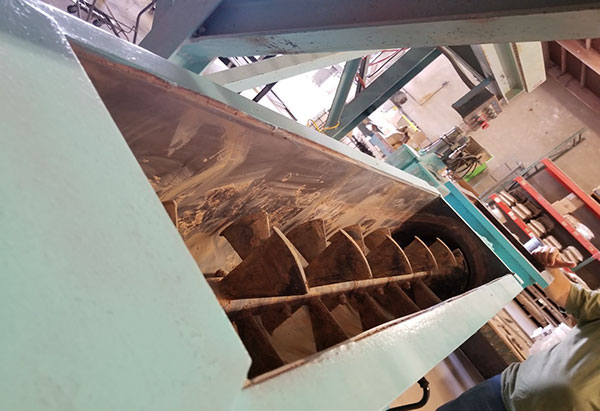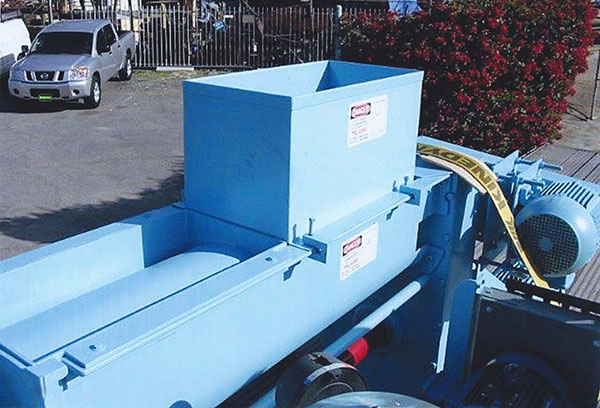Case Report: 18CA003
18-year-old laborer dies when pulled into a clay moulding machine (pug mill)
Download a PDF to print this report:
18-year-old laborer dies when pulled into a clay moulding machine (pug mill) (18CA003, PDF)
Summary
An 18-year-old laborer died when his arm was pulled into the auger compartment of a clay moulding machine (pug mill). The victim had been on the job for one month. The victim was instructed not to go near the machine when in operation without supervision. The incident was unwitnessed and it is uncertain why the victim approached the machine. The machine operator left the machine running and unattended while he left to help another operator on another machine. At the time of the incident, there was no guard around the auger compartment. The CA/FACE investigator determined that, in order to prevent similar future incidents, employers who manufacture clay materials should:
- Ensure that machinery with moving parts is properly guarded.
- Ensure that new employees are adequately supervised while working with or near operating machinery.
Introduction
On September 20, 2018, at approximately 11:00 a.m., an 18-year-old Hispanic male laborer suffered fatal injuries when he was pulled into the auger of a pug mill. The CA/FACE investigator received notification of this incident on September 29, 2018, from the Cal/OSHA Weekly Fatality Report. On October 31, 2018, contact was made with the owners of the company that was involved in this incident. On November 6, 2018, the CA/FACE investigator traveled to the employer, interviewed the company owners, reviewed the employer’s safety documentation, and took pictures of the incident scene. On November 28, 2018, a second visit was made to the incident scene where two co-workers and a supervisor were interviewed. Incident reports from the coroner, fire department, and sheriff’s department were obtained and reviewed.
Employer
The employer of the victim was a manufacturer of pottery materials and tools used in ceramic sculptures, mold makers, doll making, and murals. The company operated pug mills that mixed and manufactured the clay products for sale at retail and wholesale stores. The company had been in business for 46 years and had 30 employees at the time of the incident. Employees worked in two shifts, and there were approximately ten employees working in the shop on the day of the incident.
Written Safety Programs and Training
The company had a written injury and illness prevention program (IIPP) with all the required elements. The written safety program included rules and procedures, lockout and tagout procedures, hazard communication, personal protective equipment, and fire prevention. The written instructions for pug mill operation stated that hands should be kept away from moving parts, and that the machine should be turned off before cleaning or before inserting hands and tools. Safety meetings were not held on a regular basis and were not documented. Training for machine operators was usually accomplished by on-the-job-training (OJT) by more experienced operators. The victim attended a safety orientation when hired which included safety precautions to follow when working on or near operating equipment. The orientation was given by the shop supervisor.
Worker Information
The victim was an 18-year-old Hispanic male who had been on the job for only one month. He was hired as a laborer to package the finished product in the proper container and stack it on a pallet for shipment. He was born in the United States and spoke both English and Spanish. He was assigned to work with his stepbrother who was a machine operator.
Incident Scene
The incident scene was inside a building that contained the retail store in the front; office space, clerical room, and storage in the middle; and four pug mill machines in the shop in the back (where the incident occurred).
The Machine
The machine involved in this incident was a Walter C. Stoll and Sons pug mill and extruder (Model #SE10) that was originally manufactured in 1998. The employer had purchased this machine secondhand in 2000. During operation, a clay mixer drops the clay material (using gravity) into an auger compartment to mix and push the clay into a vacuum chamber to remove moisture. The clay is then moved into an extruder that pushes and squeezes the clay into a mold to form the desired shape requested by a customer. The auger compartment contains a rotating shaft with sharp blades (Exhibit 2) that push the clay into the vacuum chamber.
According to the manufacturer, the original equipment was sold with a chute from the mixer that enclosed the auger compartment (Exhibit 3). However, the employer installed this machine (as well as the other three pug machines) without the chute such that the auger compartment was not enclosed and had no guarding to prevent employees from reaching in. It is not known if the employer purchased the secondhand pug mill with an enclosure around the auger compartment.
Investigation
On the day of the incident, the victim was working with his stepbrother who was one of the machine operators. At approximately 11:00 a.m., his stepbrother went to assist another operator. The incident was not witnessed, but employer surveillance video showed the victim walking over to the machine involved in the incident. According to the police department report, the recorded footage appeared to show that the victim was scraping the dry clay off the edges of the unguarded auger compartment when his left arm was pulled into the blades.
No one in the immediate area observed or heard the victim getting pulled into the machine. Within a few minutes, a co-worker and the victim’s stepbrother returned to the work area, saw the victim, and immediately turned the machine off. Emergency services were called by a supervisor and found the victim unresponsive and not breathing within the auger compartment. The victim was declared dead at the scene by emergency services.
Cause of Death
According to the county coroner, the cause of death was numerous sharp force injuries.
Recommendations
The CA/FACE investigator determined that, in order to prevent similar future incidents, employers who manufacture clay materials should:
Recommendation #1: Ensure that machinery with moving parts is properly guarded.
Discussion: In this incident, the victim was removing clay from the auger compartment that was not guarded. Although the original manufacturer’s model had a chute and guard around the auger compartment, this was not in place on any of the pug mills while the victim was working. The original guard around the auger compartment was designed to prevent employees from reaching into the compartment while the pug mill was in operation. The victim was able to easily reach into the auger compartment and, in so doing, he became entangled and died. Even if the employer had purchased the pug mill without the original guard, secondary guarding could have been installed to prevent employees from reaching into the compartment and becoming caught in the auger blades. The employer installed a gate around the compartment after the incident occurred, such that the pug mill shuts down after opening. Electronic sensors can also be used to protect employees from moving parts and pinch points, as they shut down the machine whenever the sensor beam is broken. If the employer had ensured that there was guarding around the auger compartment, the victim would not have become entangled in the rotating blades.
Recommendation #2: Ensure that new employees are adequately supervised while working with or near operating machinery.
Discussion: The victim was hired as a laborer and was not a trained machine operator. The victim had been on the job for only one month. It is not known if he was familiar with the proper operation of the pug mill and methods for cleaning the clay from the auger. The victim was not witnessed walking over to the pug mill, indicating that he was not closely supervised. Employers should pay special attention to supervision of new employees, and ensure that those in supervisory positions have the appropriate training and experience to provide oversight to new employees. Supervision and inspections of the workplace and observations of work practices for adherence to safety policy and procedures can identify unsafe behaviors and emerging hazards before an injury or death occurs. Regular, frequent, and thorough inspections, audits, and observations by supervisors serve to enhance awareness and identify needs for further training. Close supervision and inspections of the immediate workplace also help to identify and eliminate any new or reoccurring hazards. Had the supervisor in this incident been in the shop area, he may have ensured the victim did not approach the machine, thereby preventing this incident.
Exhibits

Exhibit 1. A pug mill identical to the one involved in the incident.

Exhibit 2. The auger blades.

Exhibit 3. A pug mill with safety chute covering the auger blades.
References
Division of Occupational Safety and Health - Title 8 regulations - Subchapter 7 - General Industry Safety Orders.
Group 3. General Plant Equipment and Special Operations - Article 15. Vats, Pans, Bins, Bunkers, Hoppers, and Similar Containers and Vessels. §3482. Bulk Storage of Loose Material.
Group 6. Power Transmission Equipment, Prime Movers, Machines and Machine Parts - Article 41. Prime Movers and Machinery. §4002. Moving Parts of Machinery or Equipment.
Group 8. Points of Operation and Other Hazardous Parts of Machinery - Article 54. Scope and General Definitions. §4186. Maintenance and Use of Point of Operation Tools and Guards. Article 73. Stone, Clay and Glass Working Machines. §4625. Pug Mills.
Authors
Hank Cierpich, FACE Investigator
Robert Harrison, MD, MPH, FACE Project Officer
Laura Styles, MPH, Research Scientist
June 24, 2019